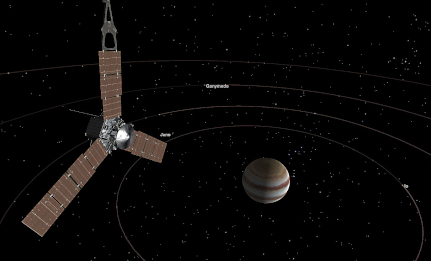- Series:Astronomy, Transcript English
Jude 1:13
“Raging waves of the sea, foaming out their own shame; wandering stars, to whom is reserved the blackness of darkness for ever. “
 In the previous few months as I write this script, the planet Jupiter has been featured heavily in items on science news websites. Much of the recent interest has been sparked by data being sent back to earth from NASA’s Juno mission, which was launched in August 2011 and entered a polar orbit around Jupiter in July 2016. Flying across the famous belts in the gas giant’s atmosphere, Juno aims to pick up vast amounts of information about the composition of the atmosphere as well as data concerning the planet’s mysterious core.
In the previous few months as I write this script, the planet Jupiter has been featured heavily in items on science news websites. Much of the recent interest has been sparked by data being sent back to earth from NASA’s Juno mission, which was launched in August 2011 and entered a polar orbit around Jupiter in July 2016. Flying across the famous belts in the gas giant’s atmosphere, Juno aims to pick up vast amounts of information about the composition of the atmosphere as well as data concerning the planet’s mysterious core.
As is so often the case today, NASA uses the data to draw inferences about how they think Jupiter must have evolved over hundreds of millions of years into its present form.
Previous planetary evolutionary models had suggested a particular size and density for the core of the planet. However, Juno’s measurements suggest a larger than expected core, which is also less dense than expected. Rather than accepting that their previous model of planetary formation was wrong, scientists have assumed that the model was right but that something has stirred up the core. So they suggest that a large solid planet ten times the size of the Earth must have crashed into Jupiter in its infancy, stirring up the material of the core.
Such ideas are borne of a refusal to accept that astronomical objects were designed by God and seek, instead, to give the glory to the created, rather than the Creator.
Prayer: Father, forgive me when I do not give You the honor and the glory You deserve but imagine that I may take some credit. Lord, You are worthy of all the honor and all the glory forever. Amen.
Author: Paul F. Taylor
Ref: Rice University. “Young Jupiter was smacked head-on by massive newborn planet: Jupiter’s core may still be reeling from collision 4.5 billion years ago.” ScienceDaily, 15 August 2019. <www.sciencedaily.com/releases/2019/08/190815113735.htm>. Image: NASA, Public Domain.
© 2020 Creation Moments. All rights reserved.
